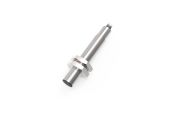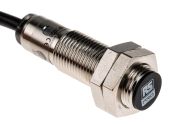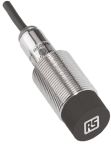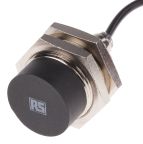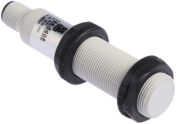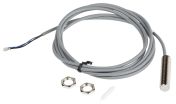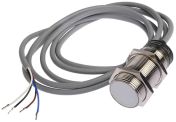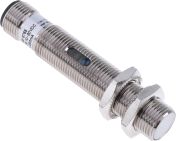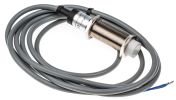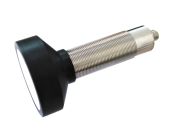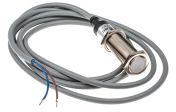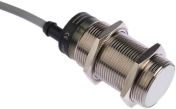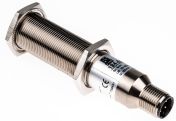Proximity Sensors
RS Malaysia is a trusted supplier of various types of proximity sensors, including ultrasonic, inductive, capacitive, IR, pneumatic and proximity detectors, designed to withstand various industrial and commercial applications. We offer sensors ranging from different prices and products from brands like Sick, Telemecanique Sensors and Carlo Gavazzi.
What Is a Proximity Sensor?
A proximity sensor is a non-contact component designed to detect the presence or absence of an object without physical contact. It offers a valuable solution for working with delicate or unstable objects. Proximity sensors have key features and benefits, including motion detection of metallic and non-metallic objects, wide temperature range (-50°C to 100°C), high-speed motion sensing without contact, usability in applications with oil or water, and quicker response times compared to contactors.
How a Proximity Sensor Works
Depending on their type, proximity sensors use various technologies to detect objects without physical contact. For instance:
Inductive proximity sensors: Generate an electromagnetic field and sense disruptions caused by the presence of metallic objects.
Capacitive proximity sensors: Detect changes in capacitance caused by any object, whether metallic or non-metallic.
Ultrasonic proximity sensors: Emit high-frequency sound waves and measure the time it takes for those waves to bounce back from an object, calculating distance based on that reflection time.
Regardless of the technology, the sensor converts the detected change into an electrical signal that can trigger a specific action in your automated system.
Types of Proximity Sensors
There are various types of proximity sensors suitable for different applications. They operate based on a universal working principle and transmit data about an object’s presence or motion via an electrical signal when the object is within the sensor's range. Here are some common types:
- Infrared Sensors (IR Sensor): Infrared sensors consist of passive infrared sensors (PIR) and active infrared sensors. PIR sensors utilise pyroelectric infrared sensors in a magnetic lens, which detect changes in the signal between them. Active IR sensors employ an IR LED that emits an infrared beam to an infrared receiver, detecting obstacles that block the infrared radiation.
- Inductive Proximity Sensors: Inductive proximity sensors generate an electromagnetic field through an oscillating circuit. Any ferrous metal object, including aluminium, copper, brass, and iron, triggers a change in the oscillation, indicating its presence.
- Capacitive Proximity Sensors: Capacitive sensors can detect various shapes and materials, even through non-metallic walls. They are suitable for use with non-ferrous materials and find applications in close-range tasks like level detection and monitoring.
- Ultrasonic Proximity Sensors: Ultrasonic sensors emit and receive high-frequency sound waves that can be reflected or absorbed by objects within their range. These sensors are ideal for high-speed and long-distance measurements, such as wind speed, fluid level, and speed through air or water.
- Magnetic Proximity Sensors: Magnetic proximity sensors measure the presence or absence of an object using an external magnetic field. The sensor's reed switch is operated by a magnet, activating the sensor when the reed switch is turned ON.
Industrial Applications of Proximity Sensors
Proximity sensors are widely used in various sectors and applications, enhancing efficiency, industrial workplace safety, and precision. They are ideal for the following:
Automation Systems
In automation systems, proximity sensors detect the presence or absence of objects to trigger specific actions. They are used in conveyor systems, packaging machines, and material handling equipment to optimise processes.
Robotics
In robotics, proximity sensors enable robots to interact with their environment safely and efficiently. They allow robots to navigate obstacles, detect the presence of objects to be manipulated, and avoid collisions.
Industrial Manufacturing
Industrial manufacturing relies heavily on proximity sensors for quality control, process monitoring, and safety. These sensors are used to detect the position of components, verify assembly steps, and monitor fill levels in containers.
Security Systems
Proximity sensors trigger alarms, activate cameras, and control access to restricted areas. Their non-contact nature makes them suitable for detecting intruders, monitoring doors and windows, and enhancing overall security measures.
Mobile Devices
Proximity sensors are also found in mobile devices, where they detect the proximity of the user's face during calls to disable the touchscreen and conserve battery life. They also play a role in various mobile applications, such as gesture control and proximity-based interactions.
Frequently Asked Questions About Proximity Sensors
What is the difference between a proximity switch and a proximity sensor?
While often used interchangeably, there is a technical distinction between the two. A proximity sensor detects an object and sends a signal, while a proximity switch directly triggers an action based on the sensor's detection. Simply put, a proximity sensor requires no physical contact while a proximity switch relies on physical contact.
What is the advantage of a proximity sensor?
Proximity sensors offer several advantages including non-contact object detection, making them suitable for fragile objects and harsh environments. They are also highly reliable, fast-acting, and have a long lifespan.
How far can a proximity sensor work?
The sensing range of a proximity sensor varies widely depending on its technology and model. Some sensors detect objects within millimetres (e.g., inductive sensors), while others have ranges of several metres (e.g., ultrasonic sensors).
Delivery Information
When you buy photoelectric sensors, pressure sensors or proximity sensors from RS Malaysia, you can expect fast and reliable delivery. We offer a variety of delivery options to meet your needs, including next-day delivery on eligible items when you order before 4:00 pm, Monday through Friday.
For a full overview of our delivery options, including estimated lead times, shipping costs, and potential exclusions, please visit our Delivery Page.
Popular Searches
Related links
- Telemecanique Sensors Ultrasonic Threaded Barrel Proximity Sensor 4 m Detection 0-10 V, 24 V dc
- Telemecanique Sensors Ultrasonic Threaded Barrel Proximity Sensor 1 m Detection 12 → 24 V dc
- Telemecanique Sensors Ultrasonic Threaded Barrel Proximity Sensor 2 m Detection 4-20 mA, 12 → 24 V dc
- Telemecanique Sensors Ultrasonic Threaded Barrel Proximity Sensor 2 m Detection 12 → 24 V dc
- Telemecanique Sensors Ultrasonic Threaded Barrel Proximity Sensor 8 m Detection 24 V dc
- Telemecanique Sensors Ultrasonic Threaded Barrel Proximity Sensor 200 mm Detection 12 → 24 V
- Telemecanique Sensors Ultrasonic Threaded Barrel Proximity Sensor 8 m Detection 12 → 24 V dc
- Telemecanique Sensors Ultrasonic Threaded Barrel Proximity Sensor 4 m Detection 12 → 24 V dc
